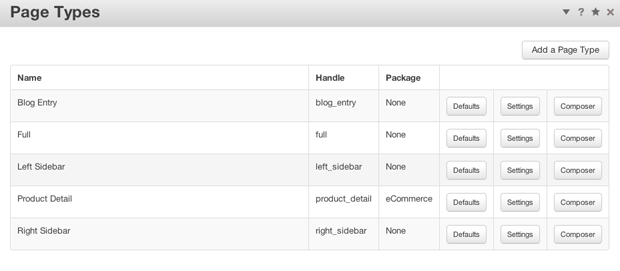Every page in your concrete5 site uses a page type. You can think of a page type as a unique "template" for laying out your page's content. Page types take the blocks from your page's areas and display them in a particular way.
One great reason for using concrete5 is that you can easily deploy a consistent look (or many looks) across all your pages -- and swap it out for something else, at a moment's notice.
Currently Installed Page Types
The Dashboard's Page Types page lists every page type currently installed on your site. Along with its Name, we can view each page type's unique handle and the name of the package (if applicable) that installed the page type.

Note in the screenshot above that the page types included in the concrete5 core themes aren't associated with a package-- they're part of the core. The Product Detail page type was installed by the eCommerce package, so it's listed as such.
When you download additional themes & add-ons from the concrete5 Marketplace that include page types, they'll be listed here (provided that the add-on or theme developer has taken the time to set them up to automatically install). Just like our Product Detail page type, they'll be listed here along with the name of the package that installed them.
Note: Excluding Single Pages are a different kind of page that doesn't use a typical page type. Instead, single page content is rendered by a special file (view.php) that is slightly different than a page type.
